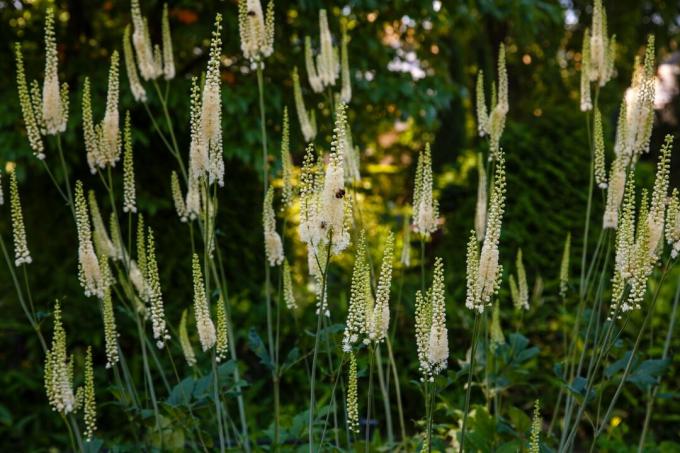The black cohosh can be used in many ways and not only convinces with its medicinal plant benefits, but also as an ornamental plant. Here you can find out how you can grow the medicinal plant yourself and what you should consider when using it.

The black cohosh (Actearacemosa), also July silver candle (Cimicifuga racemosa) is known as a medicinal plant and is mainly used to treat symptoms associated with menopause. But this silver candle is also well suited for graceful perennial gardens. In this article, you will learn all about black cohosh and how to care for it.
contents
- Black cohosh: origin and properties
- The most beautiful types and varieties
- Plant and care for black cohosh
- Harvesting, use and effects of black cohosh
Black cohosh: origin and properties
Black cohosh originally comes from North America and Canada. In the meantime, the medicinal plant can also be found in light-colored forests in our latitudes. Black cohosh, which belongs to the buttercup family (Ranunculaceae), is a herbaceous perennial plant. It grows in clumps and reaches a height of one to two meters. Below the ground is the dark root that emerges from the rhizome, a subterranean shoot. The dark green leaves are large, three to five lobed, imparipinnate. The inflorescences are on upright, thin stalks.
When does the black cohosh bloom? Flowers of the medicinal plant can be seen in the flowering period in July. Hence the trivial name July silver cohosh, by which black cohosh is also widely known. The inflorescences consist of silvery-white flowers that grow on racemes that are about 30 - 80 cm long. This cluster of flowers resembles a candle. After flowering, leathery fruits are formed that contain many seeds.

The most beautiful types and varieties
In addition to the black cohosh (synonym: July silver candle), there are other species that belong to the silver candle family. However, these have no medicinal effects. We present them to you because of their high value as ornamental plants.
- Cimicifuga ramosa (September Silver Cohosh): As its name suggests, this variety flowers in September. The flower is creamy white. With a growth height of 180 cm, it is one of the larger species.
- Cimicifuga simplex ‘Atropurpurea’ (Purple October Silver Cohosh): Even after flowering, this strain is still pretty to look at. The foliage of the silver cohosh, which is about 150 to 180 cm tall, is dark, greenish-red. The white flowers provide a nice contrast to this during the flowering period from September to October.
- Cimicifuga simplex 'Brunette' (October Silvercandle): The peculiarity of this variety lies in the dark foliage. The black-red leaves form a beautiful contrast to the white to slightly pink flowers during the flowering period from September to October. This variety reaches a height of 140-160 cm.

- Cimicifuga simplex ‘White Pearl’ (October Silver Cohosh): This variety also flowers in October, as the name suggests. With a growth height of 120 to 150 cm, it is medium-tall. The snow-white, branched panicles of flowers hang slightly over.
Plant and care for black cohosh
Black cohosh can also grow well in your garden. The acquired root pieces can be planted from spring to autumn. In summer, sufficient moisture should be ensured. Silver candles prefer a partially shaded to slightly sunny location. There should be a sufficient distance of about 100 cm between individual plants due to the herbaceous growth and the large stature height. The soil is best moist, rich in nutrients and humus. Our peat-free, for example, fulfills these properties Plantura organic compost with a high humus content. This ensures biological activity in the soil and a fertile soil.
A cut of the black cohosh is not necessary. After the perennial's flowering period is over, the foliage turns golden in the fall. Then the leaves are thrown off. The next spring, the black cohosh will sprout again from its rhizome. Silver candles in general are not sensitive to frost and hardy to around -30 °C.
Harvesting, use and effects of black cohosh
Unfortunately, the specially grown black cohosh from the garden cannot be used as a medicinal plant. Ingredients such as triterpene glycosides and flavonoids are relevant to the effect of black cohosh. They can only be found in the root. But these important ingredients are not available in sufficient quantities in the plant. However, preparations with concentrated black cohosh extract are commercially available.

Professional black cohosh preparations are used primarily as a remedy for menopausal symptoms such as sweating or hot flashes. These symptoms are triggered by the drop in estrogen levels. The ingredients of the medicinal plant have a balancing effect on these fluctuations in hormone levels. Studies have proven the effectiveness and safety of taking supplements containing black cohosh. A positive effect can occur after about two to three weeks. Long-term use should only take place after consultation with your doctor. Even before the first intake, the gynecologist can answer whether a preparation with black cohosh is basically an option.
Black cohosh is not the only medicinal plant that you can grow. In our special article we present the 10th best medicinal plants for your garden.



